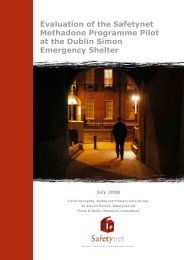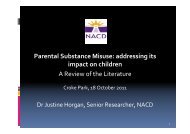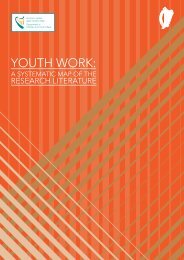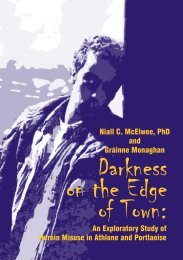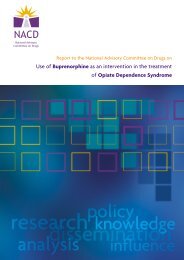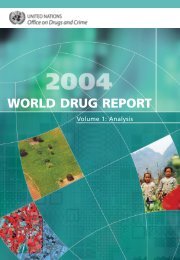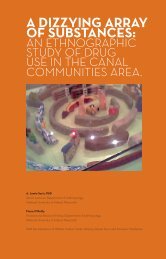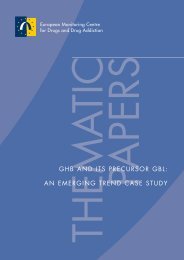Crack cocaine in the Dublin region - Health Research Board
Crack cocaine in the Dublin region - Health Research Board
Crack cocaine in the Dublin region - Health Research Board
Create successful ePaper yourself
Turn your PDF publications into a flip-book with our unique Google optimized e-Paper software.
In <strong>the</strong> UK, <strong>the</strong>re is a strong consensus that police crackdowns or targeted enforcement<strong>in</strong>itiatives that are deployed over a short period of time and focus on specific drugdeal<strong>in</strong>gareas have only limited success. Dealers often return and cont<strong>in</strong>ue to distributeillicit drugs when police resources are directed elsewhere (Burgess 2003). The mobilephone has greatly <strong>in</strong>creased <strong>the</strong> capacity of closed markets to operate withoutdetection. In addition to this, crack houses are considered to be a response to <strong>the</strong><strong>in</strong>creased polic<strong>in</strong>g of open markets. Wilson and Stevens (2008: 9) conclude: ‘Whenviewed <strong>in</strong> <strong>the</strong> context of a market, prevent<strong>in</strong>g <strong>the</strong> buy<strong>in</strong>g and sell<strong>in</strong>g of all illegal drugsis not an achievable goal of law enforcement.’ The ability of crack markets to adapt tolaw-enforcement activities has also been identified <strong>in</strong> <strong>the</strong> US. An ethnographic study<strong>in</strong> New York described how <strong>the</strong> process of crack distribution has adapted and changed<strong>in</strong> response to law-enforcement policies and competition (Johnson et al. 2000). In <strong>the</strong>late 1980s and early 1990s crack <strong>coca<strong>in</strong>e</strong> was primarily sold <strong>in</strong> <strong>the</strong> street and washighly visible. In response to law-enforcement policies, crack sell<strong>in</strong>g moved <strong>in</strong>doorsto crack houses or was sold out of what appeared to be legitimate bus<strong>in</strong>esses suchas laundromats and pool halls. <strong>Crack</strong> sellers also became more cautious about who<strong>the</strong>y sold to <strong>in</strong> response to ‘buy-bust’ techniques used by <strong>the</strong> police. These operations<strong>in</strong>volve undercover police purchas<strong>in</strong>g drugs and <strong>the</strong>n immediately arrest<strong>in</strong>g <strong>the</strong> selleronce <strong>the</strong> transaction is made. The situation <strong>in</strong> Ireland is similar to that <strong>in</strong> <strong>the</strong> UK,where <strong>the</strong> advent of mobile phones has made <strong>the</strong> operation of closed markets easier.Effective <strong>in</strong>tervention strategies may be those that comb<strong>in</strong>e attempts to disrupt localmarkets, thus render<strong>in</strong>g <strong>the</strong>m less predictable to both buyers and sellers, with attemptsto divert drug offenders <strong>in</strong>to treatment services (EMCDDA 2005). In <strong>the</strong> UK, arrestreferral schemes offer <strong>the</strong> opportunity for drug-us<strong>in</strong>g offenders deta<strong>in</strong>ed by <strong>the</strong> policeto meet with an arrest referral worker <strong>in</strong> police custody and to be referred to drugservices (Burgess 2003). However, evaluations of this scheme suggest that crack usersare <strong>the</strong> least likely to take advantage of <strong>the</strong>se schemes. Reasons for this <strong>in</strong>clude <strong>the</strong>lack of availability of immediate help, <strong>the</strong> volatility of users and a lack of faith <strong>in</strong> whattreatment services can offer. Ano<strong>the</strong>r strategy is to frustrate <strong>the</strong> operation of drugmarkets by plac<strong>in</strong>g obstacles <strong>in</strong> <strong>the</strong> way of <strong>the</strong> buy<strong>in</strong>g process. The regular patroll<strong>in</strong>gof drug hotspots and <strong>in</strong>tensive polic<strong>in</strong>g of new ‘open drug scenes’ can facilitate this.While such an approach is unlikely to deter regular drug users, it may serve to detercasual users.In recent years we have witnessed throughout Europe a greater level of debate about<strong>the</strong> most appropriate way to <strong>in</strong>tervene <strong>in</strong>, and respond to, local drug markets andrelated problems (Connolly 2006b). Strategic th<strong>in</strong>k<strong>in</strong>g, <strong>in</strong>-depth problem analysis, longtermplann<strong>in</strong>g and partnership between agencies and stakeholders are characteristicof this new development. Such partnership approaches often <strong>in</strong>volve collaborationbetween law-enforcement, social and health services, and o<strong>the</strong>r stakeholders, <strong>in</strong>clud<strong>in</strong>g<strong>Crack</strong> <strong>coca<strong>in</strong>e</strong> <strong>in</strong> <strong>the</strong> Dubl<strong>in</strong> <strong>region</strong>: an evidence base for a crack <strong>coca<strong>in</strong>e</strong> strategy101




